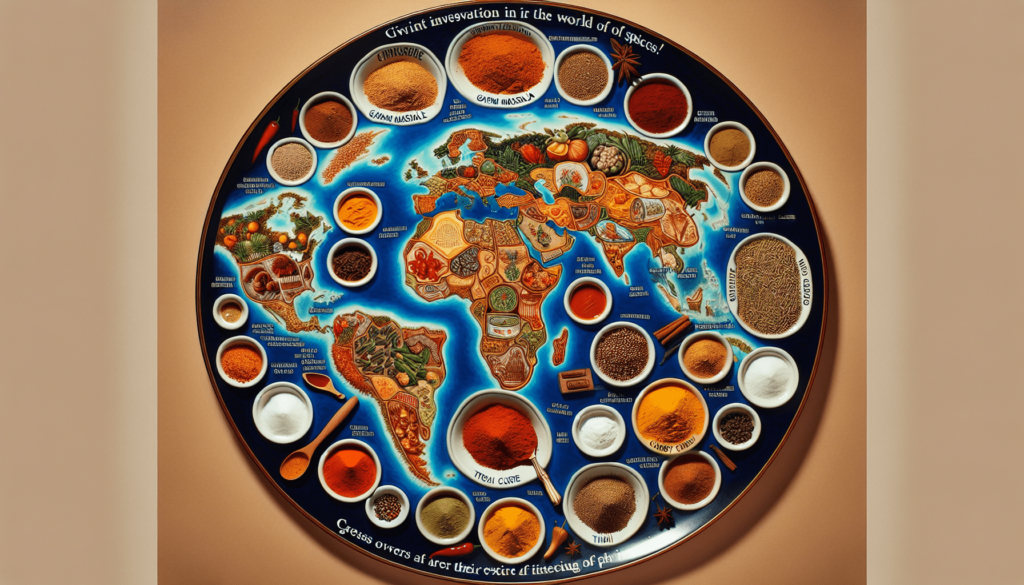Get ready to embark on a flavor-filled journey as we explore traditional seasoning blends from around the world. From the vibrant spices of India to the aromatic herbs of Italy, these blends not only add depth and complexity to your dishes but also provide a glimpse into the unique culinary traditions of different cultures. Join us as we take a global tour of traditional seasoning blends that will elevate your taste buds and inspire your inner chef.
Traditional Seasoning Blends in Asia
Chinese Five Spice
Chinese Five Spice is a traditional seasoning blend that is widely used in Chinese cuisine. It is made from a combination of five aromatic spices: star anise, cloves, Chinese cinnamon, Sichuan peppercorns, and fennel seeds. The blend offers a perfect balance of sweet, spicy, and savory flavors, making it a versatile seasoning for both meat and vegetable dishes. Whether you’re stir-frying, braising, or roasting, Chinese Five Spice adds a delightful complexity to your meals.
Japanese Furikake
Furikake is a popular Japanese seasoning blend that is typically sprinkled on rice, noodles, or fish. It is made from a combination of ingredients such as seaweed, sesame seeds, dried bonito flakes, and salt. Furikake adds a burst of umami flavor to plain rice and can be customized with various ingredients like dried shrimp, shiso leaves, or dried egg. It not only enhances the taste of the dish but also adds visual appeal with its vibrant colors.
Indian Garam Masala
Garam Masala is a classic spice blend commonly used in Indian cuisine. It is a combination of ground spices like cardamom, cinnamon, cloves, cumin, coriander, and black pepper. The name “Garam Masala” translates to “hot spice,” but it refers to the warmth and complexity of flavors rather than heat. Garam Masala adds a bold and aromatic touch to curries, lentil dishes, and roasted vegetables. It is usually added towards the end of the cooking process to preserve its fragrant qualities.
Traditional Seasoning Blends in Europe
Italian Herbs and Spices
Italian Herbs and Spices are a staple in Mediterranean cuisine and are widely used in Italian cooking. This traditional seasoning blend typically consists of dried herbs like basil, oregano, thyme, rosemary, and marjoram. The combination of these aromatic herbs creates a robust and savory flavor profile that pairs well with pasta, pizza, soups, and roasted vegetables. Whether you’re preparing a classic Margherita pizza or a hearty minestrone soup, Italian Herbs and Spices are a must-have in your pantry.
French Herbes de Provence
Herbes de Provence is a fragrant blend of herbs that originates from the Provence region in France. It typically includes herbs such as thyme, rosemary, savory, marjoram, and oregano. This versatile seasoning is perfect for adding a touch of French flair to your dishes. It works well with meats, roasted vegetables, and even in homemade bread. The aromatic blend of herbs brings the flavors of the French countryside to your kitchen.
Spanish Adobo
Adobo is a traditional seasoning blend that is widely used in Spanish and Latin American cuisine. It typically consists of a combination of spices like garlic, oregano, paprika, cumin, and black pepper. Adobo adds a rich and smoky flavor to meats, poultry, and even vegetables. The blend can be used as a dry rub or mixed with vinegar to create a marinade. With its bold and vibrant taste, Adobo brings the essence of Spanish cuisine to your recipes.

Traditional Seasoning Blends in Africa
Moroccan Ras el Hanout
Ras el Hanout is a complex and aromatic spice blend that hails from Morocco. The name translates to “top of the shop,” indicating that it is a blend of the best spices available. While the exact ingredients vary from recipe to recipe, common spices used in Ras el Hanout include cinnamon, cumin, coriander, ginger, cardamom, and turmeric. This flavorful blend is often used in Moroccan tagines, couscous dishes, and grilled meats. Its warm and fragrant profile adds a distinct North African touch to your meals.
Ethiopian Berbere
Berbere is a fiery spice blend that is a cornerstone of Ethiopian cuisine. It typically consists of a combination of spices like chili peppers, coriander, cumin, fenugreek, ginger, and cloves. Berbere adds a spicy kick and deep flavor to stews, lentil dishes, and roasted meats. The blend is versatile and can be customized based on personal preference, with some recipes calling for more heat or additional herbs and spices. If you love bold and spicy flavors, Berbere is an absolute must-try.
Nigerian Suya Spice
Suya Spice is a popular seasoning blend in Nigerian cuisine, primarily used for making suya, a delicious grilled meat skewer. The blend typically includes ingredients such as ground peanuts, ginger, garlic, chili peppers, and spices like paprika, coriander, and cayenne pepper. Suya Spice adds a unique combination of nutty, spicy, and savory flavors to grilled meats. It can also be used as a rub for roasted vegetables or sprinkled on popcorn for a spicy snack.
Traditional Seasoning Blends in the Middle East
Lebanese Za’atar
Za’atar is a versatile Middle Eastern spice blend that is widely used in Lebanon. It is made from a combination of dried herbs like thyme, oregano, marjoram, and sumac, along with sesame seeds and salt. Za’atar adds a tangy and earthy flavor to dishes and is often sprinkled on bread, salads, roasted vegetables, or used as a seasoning for grilled meats. This fragrant blend is not only delicious but also brings a taste of the vibrant Middle Eastern cuisine to your cooking.
Iranian Advieh
Advieh is a Persian spice blend that is essential in Iranian cuisine. It typically includes a mix of warm spices such as cinnamon, cumin, cardamom, nutmeg, and dried rose petals. Advieh adds a delightful aroma and depth of flavor to Persian stews, rice dishes, and kebabs. The blend is known for its ability to balance sweet and savory flavors, creating a harmonious taste experience. With its unique combination of spices, Advieh adds a touch of exotic flair to your culinary creations.
Turkish Baharat
Baharat is a popular spice blend in Turkish cuisine, as well as in other Middle Eastern countries. It typically includes a combination of spices such as black pepper, cumin, cinnamon, coriander, cloves, and nutmeg. Baharat adds a warm and aromatic flavor to a variety of dishes, including meatballs, kebabs, and vegetable stews. This versatile blend can also be used as a dry rub for grilling or as a seasoning for rice and pilaf dishes. With its rich and fragrant profile, Baharat is a staple in Turkish cooking.

Traditional Seasoning Blends in the Americas
Mexican Taco Seasoning
Taco Seasoning is a classic blend of spices that is widely used in Mexican cuisine. It typically includes chili powder, cumin, paprika, garlic powder, onion powder, and oregano. Taco Seasoning adds a burst of flavor to ground beef, chicken, or beans for tacos, burritos, and other Mexican dishes. The blend can be adjusted based on personal preference, with some recipes adding additional heat or smokiness. With its bold and vibrant taste, Taco Seasoning brings the authentic flavors of Mexico to your homemade meals.
Jamaican Jerk Seasoning
Jerk Seasoning is a traditional spice blend that originated in Jamaica and is now beloved worldwide. It typically consists of a combination of spices like allspice, cloves, cinnamon, nutmeg, thyme, and scotch bonnet peppers. Jerk Seasoning adds a fiery and aromatic flavor to grilled or roasted meats, poultry, and seafood. The blend can be used as a dry rub or mixed with oil, vinegar, or citrus juice to create a marinade. With its bold and zesty taste, Jerk Seasoning captures the essence of Jamaican cuisine.
Brazilian Tempero Baiano
Tempero Baiano is a popular seasoning blend in Brazilian cuisine, particularly in the state of Bahia. It typically includes ingredients such as parsley, garlic, chives, coriander, turmeric, and black pepper. Tempero Baiano adds a fresh and herbaceous flavor to various dishes, such as stews, fish, and rice. The blend is known for its ability to enhance the natural flavors of ingredients while adding an aromatic touch. With its vibrant and tropical taste, Tempero Baiano brings the essence of Brazil to your cooking.
Traditional Seasoning Blends in Oceania
Australian Bush Tucker
Bush Tucker is a unique seasoning blend that is derived from native Australian ingredients. It typically includes herbs and spices like lemon myrtle, wattleseed, bush tomato, pepperberry, and sea salt. Bush Tucker seasoning adds a distinct and earthy flavor to dishes, particularly those featuring Australian game meats, seafood, or vegetables. The blend highlights the rich culinary history of Australia’s indigenous cultures and showcases the diverse flavors of the Australian bush.
New Zealand Māori Seasoning
Māori Seasoning, also known as Kapowai, is a traditional seasoning blend used in Māori cuisine. Its ingredients may vary depending on regional variations, but common components include horopito (a native pepper), kawakawa (a native herb), and sea salt. Māori Seasoning adds a distinctive and fresh flavor to various dishes, including grilled meats, fish, or roasted vegetables. Rich in cultural significance, this blend pays homage to the flavors of the indigenous Māori people of New Zealand.
Hawaiian Alaea Salt
Alaea Salt is a traditional Hawaiian seasoning made from sea salt mixed with red alaea clay, which gives it its characteristic reddish color. It is commonly used in Hawaiian cuisine to season dishes like kalua pork, poke, and grilled seafood. Alaea Salt adds a mild yet savory flavor to foods and is also valued for its cultural importance. In Hawaiian mythology, the salt represents purity and blessings. Incorporating this unique salt into your dishes allows you to experience a taste of the vibrant Hawaiian culture.
Fusion Seasoning Blends
Moroccan-Inspired Curry Blend
The Moroccan-Inspired Curry Blend combines the rich and complex flavors of Moroccan cuisine with the vibrant and aromatic spices of Indian curry. This fusion seasoning typically includes spices like cumin, coriander, turmeric, ginger, cinnamon, and paprika. The blend adds a unique twist to curries, rice dishes, and roasted vegetables. With its harmonious blend of North African and South Asian flavors, the Moroccan-Inspired Curry Blend offers a delightful fusion of culinary traditions.
Mexican-Asian Fusion Taco Seasoning
The Mexican-Asian Fusion Taco Seasoning blends the bold and spicy flavors of Mexican cuisine with the umami and aromatic spices of Asian cuisine. This fusion seasoning can include ingredients like chili powder, garlic powder, cumin, black pepper, soy sauce, and ginger. The blend adds a unique and tantalizing flavor to tacos, stir-fries, or even fried rice. With its creative combination of ingredients from different culinary backgrounds, the Mexican-Asian Fusion Taco Seasoning brings a global twist to your meals.
Mediterranean-Latin Fusion Za’atar
The Mediterranean-Latin Fusion Za’atar combines the herbaceous and tangy flavors of Mediterranean Za’atar with the vibrant and zesty spices of Latin cuisine. This fusion seasoning typically includes ingredients like dried thyme, oregano, sesame seeds, chili flakes, and lime zest. The blend adds a refreshing and aromatic touch to grilled meats, roasted vegetables, or even tacos. With its fusion of Mediterranean and Latin American influences, the Mediterranean-Latin Fusion Za’atar offers a unique and exciting flavor experience.
How to Use Traditional Seasoning Blends
Enhancing Meat and Seafood
Traditional seasoning blends are excellent for enhancing the natural flavors of meat and seafood. Sprinkle Chinese Five Spice on roasted duck or pork to add depth and complexity. Use Garam Masala to marinate chicken or lamb for an Indian-inspired feast. Jamaican Jerk Seasoning works wonders when rubbed on grilled chicken or seafood, creating a fiery and aromatic dish. Each seasoning blend brings its own distinctive flavors, taking your meat and seafood dishes to new heights.
Elevating Vegetables and Side Dishes
Don’t limit the use of traditional seasoning blends to meat and seafood alone. They can also transform plain vegetables and side dishes into culinary delights. Toss roasted vegetables with Italian Herbs and Spices for a Mediterranean twist. Sprinkle Furikake on steamed rice or vegetables to add a burst of umami flavor. Moroccan Ras el Hanout can liven up couscous or roasted root vegetables with its aromatic profile. With a touch of seasoning, vegetables and side dishes become exciting and full of flavor.
Adding Flavor to Soups and Stews
Traditional seasoning blends are invaluable additions to soups and stews, infusing them with a world of flavors. Mexican Taco Seasoning gives a simmering pot of chili or tortilla soup an authentic Mexican taste. Ethiopian Berbere adds heat and complexity to lentil or vegetable stews. Za’atar can bring a tangy and herby note to Middle Eastern-inspired soups. Whether you’re making a comforting bowl of soup or a hearty stew, traditional seasoning blends can take your dish to the next level.
Tips for Making Your Own Seasoning Blends
Understanding Flavor Profiles
When creating your own seasoning blends, it’s crucial to understand the flavor profiles of different herbs and spices. Experiment with combinations of sweet, spicy, savory, and aromatic flavors to create a harmonious blend. Consider the intensity and compatibility of each ingredient to achieve a well-balanced seasoning. Balance the flavors by adjusting proportions or adding complementary spices until you achieve the desired taste.
Balancing Herbs and Spices
To create a well-rounded seasoning blend, it’s important to balance the herbs and spices used. Play with the ratios of dominant and supporting ingredients to achieve the desired flavor profile. Opt for a combination of strong spices like cumin or chili powder with milder herbs like oregano or thyme. Consider adding a touch of acidity or sweetness, such as lemon zest or brown sugar, to elevate the overall taste. Balance is key in creating a homemade seasoning blend that delights the palate.
Storing and Labeling Homemade Blends
Once you’ve created your own seasoning blend, proper storage is crucial to maintain its freshness and flavor. Store homemade blends in airtight containers, away from direct sunlight, heat, and moisture. Label the containers with the name of the blend and the date of creation to ensure you use the freshest seasoning. Additionally, keep a record of the ingredients and their proportions in case you need to recreate the blend in the future. With proper storage and labeling, your homemade seasoning blends will stay vibrant and flavorful.
Where to Buy Traditional Seasoning Blends
Local Specialty Stores
Many local specialty stores and gourmet markets offer a wide selection of traditional seasoning blends from around the world. These stores often source authentic products that capture the true essence of each cuisine. Explore your local specialty stores to discover unique and high-quality blends. The knowledgeable staff can guide you in choosing the perfect seasoning blend for your culinary adventures.
Online Retailers
Online retailers provide a convenient way to access traditional seasoning blends from various regions. Numerous websites specialize in selling international foods and spices, offering a wide range of blends. With just a few clicks, you can have the traditional seasonings delivered right to your doorstep. Read customer reviews and check the authenticity of the products before making a purchase to ensure the highest quality.
Farmers Markets
Farmers markets are excellent places to find artisanal seasonings made by local producers. Many farmers markets feature vendors who create traditional seasoning blends using locally sourced ingredients. Visiting a farmers market allows you to not only support local businesses and farmers but also discover unique and flavorful blends that are often crafted in small batches. Explore the market stalls, sample the blends, and engage with the vendors to learn more about their products.
